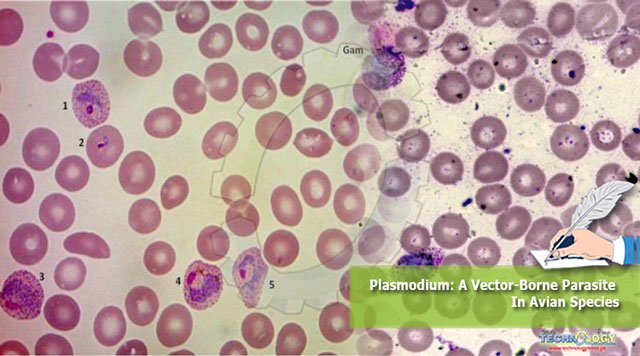Plasmodium is a protozoan parasite belonging to phylum Apicomplexa and order Haemosporidia causing malaria.

Plasmodium infects worldwide the red blood cells of mammals, including birds, reptiles and humans. Plasmodium life cycle includes the vertebrate as well as arthropod vector. Vertebrate host mainly includes birds, reptiles, rodents, monkeys and humans. Invertebrate host mainly includes mosquitoes belonging to Culex, Aedes or Culiseta species. These are hosted specific species with no zoonosis. Plasmodium affect both domestic as well as wild birds almost 65 species of plasmodium causes avian malaria. Worldwide most pathogenic species include p. gallinaceum, p. juxtranucleare, and p. durae. 90% mortality caused due to severe anemia and blockage of capillaries in the lung, brain and other vital organs. For assessing the transmission of disease first exposure of birds to this infection is essential. Plasmodium is a seasonal infection that depends on the occurrence of the vector at that time. Penguins mostly die in the summer season from June-October. Frequently exposure to a parasite is not risky, and birds that survive progress the primary immunity and leads to stubborn parasitemia with no sign and symptom which is known as premonition and birds are not capable of removing the parasite from the body because in the body develop antibodies against parasite and bird becomes immune to infection. For other birds, these birds serve as reservoirs. Penguin’s rarely transmitted circulating parasites usually do not contribute to the spread of malaria.
Life cycle:
Plasmodium species have a heterogeneous life cycle, including both sexual and asexual stages. Sexual reproduction occurs in the midgut of mosquito by the development of mobile ookinetes. Mobile ookinete is produced by the union of male and female gametes that lead to the formation of zygote then distinguish into a mobile ookinete. Then it enters into the midgut of mosquito and converts into an oocyst within oocyst thousands of sporozoites are produced until it ruptures and releases sporozoites. These sporozoites migrate to the mosquito’s salivary gland, so while biting the bird’s mosquitoes, transfer the sporozoites to birds by biting mosquito transfer sliver along with sporozoites in bird’s body. Sporozoites, through blood circulation, reach different organs and convert to cryptozoites and then with cryptozoites develop merozoites and infect the macrophages in several organs of birds’ bodies.
Lesions in avian species:
- Liver and spleen become dark brown to black (discolored)
- Hepatomegaly and splenomegaly (enlarged liver and spleen)
- Mature and immature RBCs pigmented parasites are present
- A parasite is also present in WBCs and thrombocytes
- Sudden death can occur due to severe anemia and blockage of capillaries in the brain, lung and other vital organs.
Diagnosis of plasmodium in avian species:
- Blood smear
- Impression smear of liver and spleen and stained with wright or Leishman’s Giemsa stain and observes directly on the microscope
- After 8 days of infection, plasma protein profile changes gamma 1globulin and gamma2 globulin were enhanced, and alpha 2 globulin and albumin were declined.
- Diagnosis of disease by using PCR through targeting 18s ribosomal gene subunit or cytochrome b mitochondrial gene this one is more effective than the 18s ribosomal gene subunit.
Treatment of avian plasmodium:
- Commercially no approved antimicrobial drug is available to cure the avian.
- Infeed combination of sulfa quinoxaline and trimethoprim for 5 days has been effective against p gallinaceum malaria in chicken.
- 50mg/kg chloroquines in leghorn chicken are effective; grape and orange juice compensate for the bitterness of chloroquines.
- 10mg/kg chloroquine and primaquine 0.3-1 mg/kg orally been effective against malaria in cage birds and penguins. For songbirds, chloroquines at 250mg/120 ml drinking water is effective.
- Chloroquine and primaquine treatment in combination is recommended because against tissue schizonts, primaquine is effective, and chloroquines are effective against gametocytes and erythrocytic schizonts.
Control and preventive measure:
- Prevention is better than cure.
- As mosquito act as a vector so by controlling the mosquitoes helps to reduce the burden of disease
- The antimalarial drug is useful in declining the brutality of infection
- Passive immunity also help to deduce the disease
- Keep penguins in mosquitoes free indoor convenience
- Pesticides spray
- Antimalarial vaccination
- Complete confinement of birds during warm months when the mosquitoes number are enhanced
- For controlling the mosquitoes larvae, the population used the mosquitoes eating fish like fathead minnows in the pound, and some bacteria such as bacillus thuringiensis is also helpful in controlling the mosquito’s larvae population.
- Eliminating standing water and used CO2 mosquitoes trap to reduced mosquitoes population near the birds
- Administration of primaquine daily or weekly basis is also helpful in deducing the disease.
Economic impact:
Avian malaria infects both commercial and local birds, including penguins worldwide as poultry plays a vital role in enhancing the economy of the country, so avian malaria causes huge economic losses in Pakistan, India and Bangladesh.
- Department of Pathology, Faculty of veterinary science, University of Agriculture, Faisalabad
- MOE Joint International Research Laboratory of Animal Health and Food Safety, College of Veterinary Medicine, Nanjing Agricultural University, 210095 Nanjing, P.R.China
Dr. Maria Jamil1, Dr. Aisha Khatoon1, Dr. Kashif Saleemi1, Dr. Naima Waheed1 , Dr. Muhammad Tahir Aleem2
